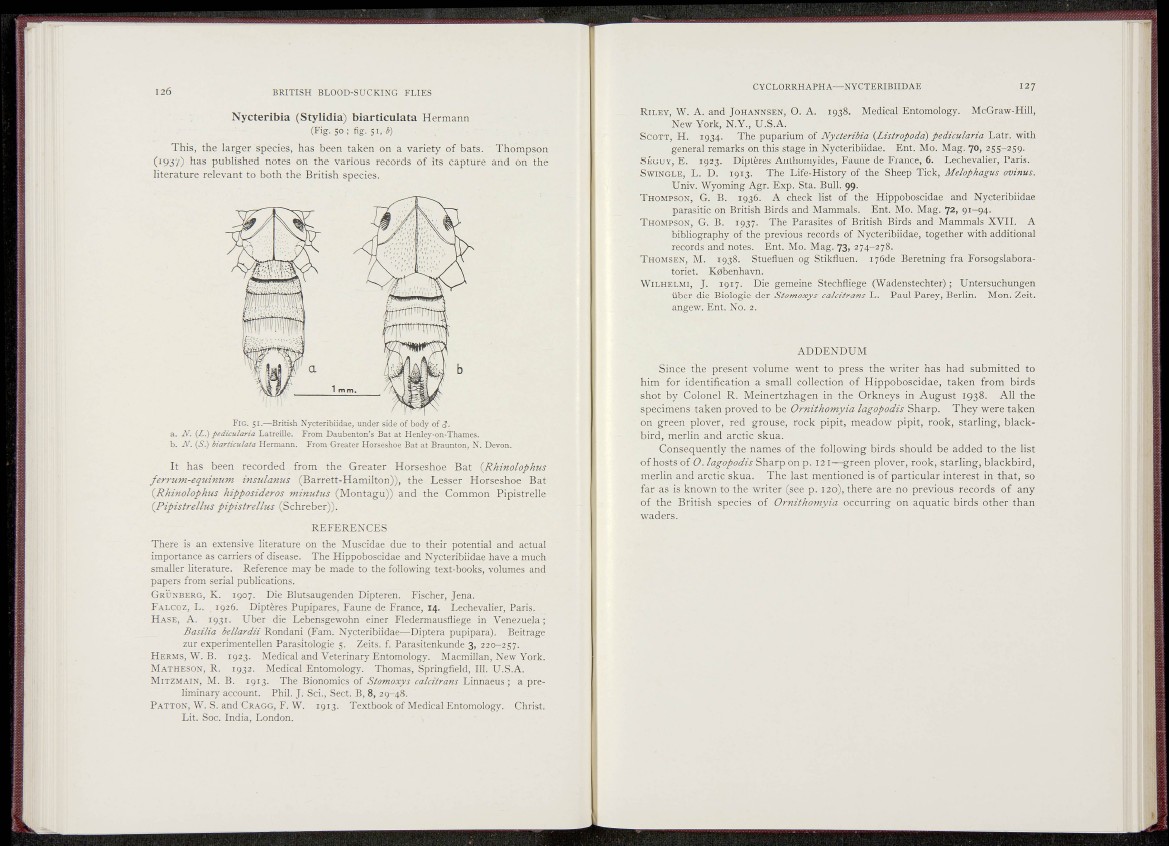
126 B R I T I SH BLOOD-SUCKING FLIES
Nycteribia (Stylidia) biarticulata Hermann
(Fig. 50 ; fig. 51,
This, the larger species, has been taken on a variety of bats. Thompson
(1937) has pubhshed notes on the various records of its capture and on the
literature relevant to both the British species.
FIG. 51.—British Nycteribiidae, under side of body of CJ.
a. A'. (Z.) pedicularia Latreille. From Daubenton's Bat at Henley-on-Thames.
b. N. {S.) biarticulata Hermann. From Greater Horseshoe Bat at Braunton, N. Devon.
It has been recorded from the Greater Horseshoe Bat {Rhinolophus
ferrum-equinum inszilanus (Barrett-Hamilton)), the Lesser Horseshoe Bat
(^Rhinolophus hipposideros mi7iutus (Montagu)) and the Common Pipistrelle
(^Pipistrellus pipistrelhis (Schreber)).
REFERENCES
There is an extensive literature on the Muscidae due to their potential and actual
importance as carriers of disease. The Hippoboscidae and Nycteribiidae have a much
smaller literature. Reference may be made to the following text-books, volumes and
papers from serial publications.
GRL"NBERG, K. 1907. Die Blutsaugenden Dipteren. Fischer, Jena.
FALCOZ, L. 1926. Diptères Pupipares, Faune de France, 14. Lechevalier, Paris.
HASE, A. 1931. Uber die Lebensgewohn einer Fledermausfliege in Venezuela;
Basilia bellardii Rondani (Fam. Nycteribiidae—Diptera pupipara). Beitrage
zur experimentellen Parasitologie 5. Zeits. f. Parasitenkunde 3, 220-257.
HERMS, W . B. 1923. Medical and Veterinär}- Entomology. Macmillan, New York.
MATHESON, R. 1932. Medical Entomology. Thomas, Springfield, 111. U.S.A.
MITZMAIN, M. B. 1913. The Bionomics of Stomoxys calcitraris Linnaeus ; a preliminary
account. Phil. J. Sei., Sect. B, 8, 29-48.
PATTON, W . S. and CRAGG, F. \V. 1913. Textbook of Medical Entomology. Christ.
Lit. Soc. India, London.
C Y C L O R R H A P H A — N Y C T E R I B I I D A E 127
R I L E Y , W. A. and JOHANNSEN, O. A. 1938. Medical Entomology. McGraw-Hill,
N e w York, N.Y. , U.S.A.
SCOTT, H . 1934. The puparium of Nycteribia [Listropodd) pedicularia Latr. with
general remarks on this stage in Nycteribiidae. Ent. Mo. Mag. 70, 255-259.
SÉGUY, E. 1923. Diptères Anthomyides, Faune de France, 6. Lechevalier, Paris.
SWINGLE, L. D. 1913. The Life-History of the Sheep Tick, Melophagus ovinus.
Univ. Wyoming Agr. Exp. Sta. Bull. 99.
THOMPSON, G. B. 1936. A check list of the Hippoboscidae and Nycteribiidae
parasitic on British Birds and Mammals. Ent. Mo. Mag. 72, 91-94.
THOMPSON, G. B. 1937. The Parasites of British Birds and Mammals X V I I . A
bibliography of the previous records of Nycteribiidae, together with additional
records and notes. Ent. Mo. Mag. 73, 274-278.
THOMSEN, M. 1938. Stuefluen og Stikfluen. i76de Beretning fra Forsogslaboratoriet.
K0benhavn.
W1LHELMI, J. 1917. Die gemeine Stechfliege (Wadenstechter) ; Untersuchungen
über die Biologie der Stomoxys calcitrans L. Paul Parey, Berlin. Mon. Zeit,
angew. Ent. No. 2.
ADDENDUM
Since the present volume went to press the writer has had submitted to
him for identification a small collection of Hippoboscidae, taken from birds
shot by Colonel R. Meinertzhagen in the Orkneys in August 1938. All the
specimens taken proved to be Ornithomyia lagopodis Sharp. They were taken
on green plover, red grouse, rock pipit, meadow pipit, rook, starling, blackbird,
merlin and arctic skua.
Consequently the names of the following birds should be added to the list
of hosts of O. lagopodis Sharp on p. 121—green plover, rook, starling, blackbird,
merlin and arctic skua. The last mentioned is of particular interest in that, so
far as is known to the writer (see p. 120), there are no previous records of any
of the British species of Ornithomyia occurring on aquatic birds other than
waders.